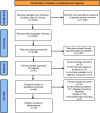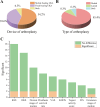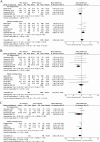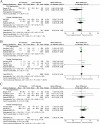The impact of patellofemoral joint diseases on functional outcomes and prosthesis survival in patients undergoing unicompartmental knee arthroplasty: a systematic review and meta-analysis
- PMID: 39696549
- PMCID: PMC11656892
- DOI: 10.1186/s13018-024-05273-y
The impact of patellofemoral joint diseases on functional outcomes and prosthesis survival in patients undergoing unicompartmental knee arthroplasty: a systematic review and meta-analysis
Abstract
Background: Patellofemoral joint (PFJ) diseases are chronic degenerative conditions that contribute to knee joint symptoms. Unicompartmental knee arthroplasty (UKA) is widely regarded as an effective treatment for knee osteoarthritis (KOA); however, its specific indications remain a subject of debate.
Hypothesis: Patients with PFJ disease are expected to experience outcomes post-UKA comparable to those of patients without PFJ disease.
Methods: We conducted this meta-analysis following the guidelines outlined by the Preferred Reporting Items for Systematic Reviews and Meta-analyses (PRISMA). A comprehensive search of PubMed, Embase, and Web of Science databases was conducted for studies examining the association between PFJ disease and UKA, including publications up to September 2024. Extracted data encompassed author, publication year, country, disease type, prosthesis type, sample size, mean patient age, gender distribution, follow-up duration, PFJ disease prevalence at surgery, diagnostic methods, and whether PFJ disease was considered a contraindication for UKA. To maintain objectivity, only studies in which PFJ diseases were visually identifiable were included in the meta-analysis. Statistical analyses were performed using Stata 15.0 and Review Manager 5.4.1. A random-effects meta-analysis was conducted to evaluate the Oxford Knee Score (OKS), Knee Society Score (KSS), flexion range of motion (ROM), Forgotten Joint Score (FJS), Tegner activity score, and prosthesis survival rate, with outcomes stratified by PFJ disease type (PFJ degeneration or patella cartilage injury). Mean differences, confidence intervals, and P values were calculated for comparisons between the PFJ disease and non-PFJ disease groups. The Methodological Index for Non-Randomized Studies (MINORS) criteria and the Newcastle-Ottawa Scale (NOS) were applied to evaluate the risk of bias. To address heterogeneity, sensitivity analyses were performed, and publication bias was assessed using funnel plots and Egger's test.
Results: A total of 14,866 knees from 48 relevant studies were included in this systematic review. Methodological quality was assessed using the MINORS criteria, with case series scoring 11.0/16 and cohort studies scoring 18.2/24. PFJ degeneration emerged as the most studied condition, followed by patella cartilage injury. Clinical outcomes assessments indicated that medial PFJ degeneration, anterior knee pain, patella cartilage damage, and patella baja did not significantly impact UKA outcomes or prosthesis survival. However, severe lateral PFJ degeneration, lateral patellar subluxation, lateral trochlear osteophytes, and patellar bone marrow edema did influence results. Fifteen high-quality studies were included in the meta-analysis, involving 6080 patients-1338 in the PFJ disease group and 4,742 in the non-PFJ disease group. With an average NOS score of 7.2, the studies were generally of high quality. Meta-analysis results showed no significant differences between groups in final follow-up OKS, FJS, Tegner activity score, or prosthesis survival rate. However, the PFJ disease group had lower KSS and reduced flexion ROM compared to the non-PFJ disease group. Subgroup analysis further revealed that the PFJ degeneration group scored lower than the patella cartilage injury group on OKS, KSS, and flexion ROM following UKA.
Conclusion: In summary, PFJ disease was found to have limited impact on UKA outcomes; however, caution is recommended for cases involving severe lateral PFJ degeneration due to potential restrictions in postoperative knee function, particularly affecting flexion ROM in UKA patients.
Keywords: Bicompartmental knee arthroplasty; Knee osteoarthritis; Patellofemoral joint disease; Total knee arthroplasty; Unicompartmental knee arthroplasty.
© 2024. The Author(s).
Conflict of interest statement
Declarations. Ethics approval and consent to participate: Not applicable. Consent for publication: Not applicable. Competing interests: The authors declare that they have no competing interests.
Figures





Similar articles
-
Influence of patellofemoral joint degeneration on clinical outcomes after medial unicompartmental knee arthroplasty.Chin Med J (Engl). 2023 Jul 5;136(13):1539-1550. doi: 10.1097/CM9.0000000000002099. Chin Med J (Engl). 2023. PMID: 36730986 Free PMC article.
-
Anterior knee pain and evidence of osteoarthritis of the patellofemoral joint should not be considered contraindications to mobile-bearing unicompartmental knee arthroplasty: a 15-year follow-up.Bone Joint J. 2017 May;99-B(5):632-639. doi: 10.1302/0301-620X.99B5.BJJ-2016-0695.R2. Bone Joint J. 2017. PMID: 28455472
-
Does Medial Patellofemoral Osteoarthritis Influence Outcome Scores and Risk of Revision After Fixed-bearing Unicompartmental Knee Arthroplasty?Clin Orthop Relat Res. 2019 Sep;477(9):2041-2047. doi: 10.1097/CORR.0000000000000738. Clin Orthop Relat Res. 2019. PMID: 31140980 Free PMC article.
-
Cemented versus cementless Oxford unicompartmental knee arthroplasty for the treatment of medial knee osteoarthritis: an updated systematic review and meta-analysis.Arch Orthop Trauma Surg. 2024 Sep;144(9):4391-4403. doi: 10.1007/s00402-024-05539-4. Epub 2024 Sep 19. Arch Orthop Trauma Surg. 2024. PMID: 39294529
-
Is patella facet arthritis a contraindication to unicompartmental knee arthroplasty: Current concepts.J ISAKOS. 2024 Dec;9(6):100343. doi: 10.1016/j.jisako.2024.100343. Epub 2024 Oct 16. J ISAKOS. 2024. PMID: 39419310 Review.
Cited by
-
A novel technique of intraoperative infiltration between posterior capsule and popliteal artery can reduce opioid consumption and blood loss in total knee arthroplasty surgery: an age- and gender-matched study.J Orthop Surg Res. 2025 Feb 26;20(1):205. doi: 10.1186/s13018-025-05605-6. J Orthop Surg Res. 2025. PMID: 40011947 Free PMC article.
-
Satisfied with the worst health outcomes or unsatisfied with the best: explaining the divergence between good patient-reported outcomes and low satisfaction and vice versa among knee arthroplasty patients - a retrospective cohort study.J Orthop Surg Res. 2025 Jan 23;20(1):88. doi: 10.1186/s13018-025-05507-7. J Orthop Surg Res. 2025. PMID: 39849486 Free PMC article.
-
The efficacy of liposomal bupivacaine in parasacral ischial plane block for pain management after total knee arthroplasty: a randomized controlled trial.J Orthop Surg Res. 2025 Apr 4;20(1):342. doi: 10.1186/s13018-025-05733-z. J Orthop Surg Res. 2025. PMID: 40186266 Free PMC article. Clinical Trial.
-
Robot-assisted total knee arthroplasty is more precise than conventional total knee arthroplasty in restoring knee, but not ankle alignment: a retrospective study based on imaging data.J Orthop Surg Res. 2025 Mar 14;20(1):281. doi: 10.1186/s13018-025-05678-3. J Orthop Surg Res. 2025. PMID: 40082987 Free PMC article.
-
Comparison of VTE prophylaxis agents on hemoglobin levels after total knee arthroplasty: a hospital information system-based observational study.J Orthop Surg Res. 2025 Jun 16;20(1):589. doi: 10.1186/s13018-025-06004-7. J Orthop Surg Res. 2025. PMID: 40524197 Free PMC article.
References
-
- Sherman S, Plackis A, Nuelle CW. Patellofemoral anatomy and biomechanics. Clin Sports Med. 2014;33(3):389–401. 10.1016/j.csm.2014.03.008. - PubMed
-
- Davies A, Vince A, Shepstone L, Donell S, Glasgow M. The radiologic prevalence of patellofemoral osteoarthritis. Clin Orthop Relat Res. 2002;402:206–12. 10.1097/00003086-200209000-00020. - PubMed
-
- Crossley KM, Stefanik JJ, Selfe J, Collins NJ, Davis IS, Powers CM, et al. 2016 patellofemoral pain consensus statement from the 4th international patellofemoral pain research retreat, manchester. Part 1: terminology, definitions, clinical examination, natural history, patellofemoral osteoarthritis and patient-reported outcome measures. Br J Sports Med. 2016;50(14):839–43. 10.1136/bjsports-2016-096384. - PMC - PubMed
Publication types
MeSH terms
Grants and funding
LinkOut - more resources
Full Text Sources
Medical

